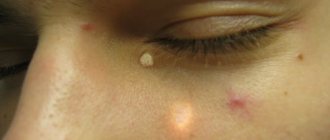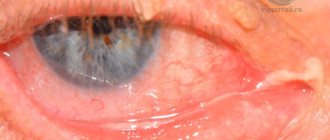Eyewinker
Various kinds of specks, grains of sand, crumbs, eyelashes, midges, etc. often get into the eyes of both children and adults, especially in the summer. In most cases, you can cope with the problem yourself by removing the foreign body from the eye by rinsing or even using your fingers, but sometimes you have to seek the help of a specialist. How to remove speck in the eye yourself?
This can be done by rinsing the eye with boiled water. To do this, you need to lower your face into the water or scoop it up with your palms, and then blink frequently so that the water can wash away the speck. If a splinter gets under the lower eyelid, pull it down and try to rinse the eye.
Or try to pick up a foreign body from the eyelid with a wet cotton pad (under no circumstances use dry cotton so as not to injure the eye by friction and leave lint in it). If a splinter has gotten under your upper eyelid, also pull it back and tug back and forth several times.
After removing the speck from the eye, it is necessary to rinse the eye with clean water and drip a disinfectant, for example, Albucid, Tobrex or levomecithin drops.
Splinter in the eyeball, foreign body in the eye
Remember that if a speck gets into your eye, do not rub it with your hands. All actions to remove a splinter from the eye must be performed only with clean hands! If a splinter gets into your eyeball, you should immediately consult a doctor. Glycerin can be dropped into the eye first.
If you don’t have glycerin on hand, you can use sterilized vegetable oil or Vaseline and generously smear your eyes with these products. Before visiting a doctor, apply a bandage with a soft cotton pad to the sore eye. This is necessary in order to prevent damage to the eyeball. Also, the headband will help you not to blink and eliminate the possibility of shifting your gaze.
For people working in the construction industry, it often happens that small pieces of iron filings get into the eye. They are easy to remove if you immediately bring a magnet to your eye. You should never rub your eye to avoid damaging the cornea with a hard and sharp piece of metal.
If lime gets into your eyes, you can use a weak sugar solution. In combination with lime, sugar has a neutralizing effect on it, resulting in a rapid decrease in pain and inflammation. But remember that it is better to wear safety glasses when working with lime.
How to get rid of a splinter in the eye at home
How to remove a splinter from an eye at home - this problem requires a special approach. Wrong actions can cause enormous damage and injury to the organ of vision, therefore, before you begin to remove a foreign body, you should understand the seriousness of the situation.
Determining the severity of the situation
The first step is to determine the nature of the foreign body. Unpleasant sensations in the eye can be caused by a small speck or eyelash, which can be removed independently, as well as a splinter, scale or shavings that require the participation of a specialist.
Chemical burns require special attention from specialists: if, after working with auto chemicals or oils, you experience discomfort similar in symptoms to a foreign body getting into the eye, immediately go to the emergency room or the emergency room of the ophthalmology department.
If the process of blinking gives you noticeable discomfort, go to the mirror and look at what exactly got into your eye. If you think that you can get a foreign object at home, prepare everything you need and proceed.
How to remove a splinter from an eye
So, if you are sure that the splinter is not serious and you can handle it on your own, proceed to remove it. Be sure to wash your hands and wipe them with a disinfectant (alcohol wipe or chlorhexidine solution). To remove small foreign bodies, use one of the following methods:
- A small speck or eyelash can be easily removed by rinsing your open eyes with cooled boiled water.
- If a foreign body is stuck under the lower eyelid, it should be pulled out and carefully moved from the outer corner of the eye to the inner corner with a cotton swab soaked in boiled water without strong pressure. A speck or eyelash will stick to the cotton wool or move into the inner corner of the eye as it moves.
- The eyelash can be removed from the eye by applying a fingernail or finger to it: the hair will stick and you will no longer feel discomfort. This should be done only after thoroughly disinfecting your hands.
After this, you should check whether the problem is really solved: close your eyes and move your eyeball. If there is no pain left, then the splinter has been removed. As a preventive measure, it is necessary to instill chloramphenicol drops into the eye.
When not to touch a thorn in your eye
Sometimes unnecessary actions can only do harm: if a small speck gets into your eye, which you feel but don’t see, it’s better not to touch it.
Nature has built protective mechanisms into our visual organs: tear production will increase and the foreign object will quickly “float away” to the inner corner when blinking.
These natural processes help avoid unnecessary injury to the eye, even when a small foreign object is under the skin.
Also, you should not touch a thorn in the eye if you understand that you cannot remove it yourself. Fruitless attempts to remove a foreign body with a cotton swab or finger will lead to injuries that will subsequently have to be treated for a long time.
In what cases is medical intervention necessary?
So, when should you see a doctor? You will need to visit a specialist in the following cases:
- if a foreign body is under the upper eyelid;
- if a splinter or metal shavings are visible in the eyeball;
- if drops of motor oils or other chemicals get into your eyes.
You will need to visit an ophthalmologist if, after independently removing the foreign body from the eye, you continue to feel discomfort and pain when blinking. This symptom indicates the presence of an injury that requires treatment with antibacterial drops, which should only be administered by a qualified specialist.
Before going to the doctor, you must prepare: drop glycerin into the injured eye and cover it with a cotton-gauze bandage, securing it with an adhesive plaster. This measure will help protect the organ of vision and prevent painful movements of the eyelid and eyeball.
Conclusion
How to remove a splinter from your eye? Before you take independent action, you need to assess the seriousness of the situation in which you find yourself.
A small speck can often be left alone; it will come out on its own due to increased tear production.
Eyelashes and debris can be washed out of the eye with water or removed with a cotton swab, but foreign bodies such as splinters, scale or metal shavings are a serious case that requires a visit to an ophthalmologist.
If you have any questions, please let us know Ask a Question
Independent actions in such situations can cause irreparable harm to your vision. Unsuccessful attempts to remove the splinter will lead to eye injury and the risk of inflammatory processes.
Even if you managed to remove a foreign object at home, do not be lazy to contact a specialist so that the doctor can examine you and make sure that there are no injuries or scars left on the cornea.
If necessary, the ophthalmologist will prescribe you a course of anti-inflammatory and antibacterial drops that will help your eye recover without negative consequences for vision.
Source: https://help-advisors.com/kak-vytashchit-zanozu-iz-glaza.html
A splinter got into the eyelid
There are situations when a splinter does not enter the eyeball, but from the inside into the eyelid. In this case, assistance in removing the foreign body from the eye can be done independently. To do this, you must first wash or disinfect your hands well, prepare a clean cotton swab and lubricate it with any neutral fat (it is not recommended to use saliva, since it contains a large number of pathogenic microbes).
The victim should be placed horizontally, on his back, and pulled by the eyelashes in such a way as to try to turn the eyelid out or at least be able to lift it above the eyeball. With the other hand, you need to run a cotton swab along the inside of the eyelid several times. Movements should be carried out in the direction of the bridge of the nose. After this, you can release the eyelid, wait 30 seconds and ask the victim to move his pupils. At the same time, the eye must remain closed.
If acute stabbing pain persists, the procedure for removing the foreign body from the eye must be repeated. If the second attempt is unsuccessful, and the victim still has the feeling of a foreign body in the eye, it is recommended that you consult an ophthalmologist. Before coming to the doctor, it is better to apply a bandage to the injured eye.
How to remove a splinter from the skin and a speck from the eye
A tiny, almost invisible splinter in a finger or a speck in the eye causes constant concern and can lead to inflammation, suppuration or damage to the eyeball with further development of corneal clouding. Avoiding such microtraumas is not easy. Therefore, you need to know exactly how to eliminate them correctly and safely.
Eyewinker
If a speck gets into your eye, never try to pull it towards your temple - the “popular” recommendation “three to the nose, and everything will go away” appeared for a reason.
But another, more exotic, “grandmother’s” method should not be used, namely, removing specks with the tongue. This procedure requires the performer, firstly, to have certain experience, and secondly, the absence of harmful bacteria in the oral cavity. And if experience can at least be gained (of course, with a sufficient number of volunteers), then it is almost impossible to expel bacteria from the mouth.
By the way, if a piece of iron filings gets into your eye, you can easily remove it by holding a magnet to your eye. In this case, under no circumstances should you rub your eye, so as not to injure the cornea with a hard and sharp piece of metal.
And if lime gets into your eyes, then a more unexpected remedy will help: you need to moisten your eyeballs as quickly as possible with a saturated sugar solution. Sugar, combining with lime, neutralizes it, the pain quickly subsides and inflammation stops. But since lime corrodes the mucous membrane very quickly, when starting to work with it, just in case, prepare a sugar solution in advance, or even better, use safety glasses.
A splinter got into my eye
Consult a doctor immediately, having first dropped glycerin into the eye or greased it with Vaseline or vegetable oil (sterilized). Place a bandage with a soft cotton pad over the injured eye to prevent you from blinking or shifting your gaze.
Sometimes the splinter does not stick into the eyeball itself, but into the eyelid from the inside. In this case, you can do it on your own. Prepare a cotton swab lubricated with any neutral fat (it is not advisable to use saliva due to the large number of pathogenic microbes in it). Lay the victim horizontally and, pulling the eyelashes, try to turn the eyelid inside out or at least lift it above the eyeball.
With your other hand, swipe the cotton swab several times along the inside of your eyelid towards the bridge of your nose. Release the eyelid and after half a minute of complete rest, ask the victim to move his pupils without opening his eyes. If the sharp stabbing pain persists, repeat the operation. If it doesn’t help again, it’s better to consult a doctor and “preserve” the eye, as in the case of a splinter getting into the eyeball.
A splinter stuck into the skin
Grabbing a wooden railing or stomping barefoot on the floor can easily cause a splinter in your arm or leg. It's even more dangerous if a tiny shard of glass penetrates your skin.
When a splinter penetrates the tissue close to the nerve ending, and its protruding tip touches objects, we immediately notice it by the sharp stabbing pain.
But sometimes, when we get into less sensitive areas of the body, we realize the presence of an uninvited guest only by the development of the inflammatory process, when swelling, throbbing pain, and suppuration begin. This means that the wound has become infected.
Trying to pull out a splinter by scraping its location with your fingers is not only useless, but also dangerous. Most likely, you will simply break off the tip sticking out above the surface of the skin, and then it will be much more difficult to pull it out even with the help of tools.
When starting a small operation, first wash your hands and the area around the injury.
If the splinter is very small, try to press firmly on both sides of the skin around it: perhaps it will come to the surface on its own. You can try to loosen a splinter that is a little longer and pry it off with a thin needle or pin. Before use, they will need to be sterilized (by calcining the tip over the fire of a burning match or lighter, holding it in boiling water for five or more minutes, or treating it with at least a 30 percent alcohol solution).
You can use a more convenient tool. It is best if you have tweezers with thin, flat tips at your disposal. When removing a shallow splinter, it is enough to grab its protruding part with tweezers and pull at the same angle at which it entered the skin.
If the splinter sits too deep or the tip has broken off, you will have to “survive” it using conservative methods. Dip the damaged area of the body in warm soapy water for 15 minutes. And so on several times a day, until the tissue around the damage loses its density and releases the unpleasant guest.
In some cases, you will still need to see a doctor to make a small incision to remove the splinter.
If you managed to remove the splinter at home, check to see if there are any foreign particles left inside the wound (for example, a broken tip). To do this, it is usually enough to press on the surface of the damaged skin with your finger or nail. If the pain is dull, aching, then the wound is empty, but if it is sharp, stabbing, then there is at least one sharp particle left, which will still cause inflammation.
Wash the wound that has been cleared of the foreign body with clean running water, then with a soap solution. Blot with a sterile bandage, lubricate with disinfectant ointment and cover with a bandage to prevent infection from entering from the outside.
Watch the wound carefully for several days: if there is redness, slight swelling around the wound, or a fever (not in the whole body, but around the wound), then the infection has penetrated there, and you should seek the help of a doctor to make an incision, disinfect it, and administered an antibiotic.
What not to do if a foreign body gets into the eye
If a foreign body is detected in the eye, there is no need to try to pull it out, moving in the direction from the bridge of the nose to the temple. All manipulations with the eye are performed only in the opposite direction - to the bridge of the nose, otherwise you can only drive the splinter into the eye even more and damage it.
Another exotic method of getting rid of specks in the eye is to lick it with your tongue, which is not recommended in any case, since such a procedure can lead to infection of the wound with pathogenic bacteria from the oral cavity.











